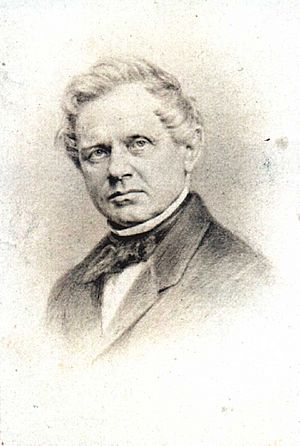Heinrich Gustav Magnus facts for kids
Quick facts for kids
Gustav Magnus
|
|
|---|---|

Heinrich Gustav Magnus
|
|
| Born | 2 May 1802 Berlin, Brandenburg, HRE
|
| Died | 4 April 1870 (aged 67) Berlin, Germany
|
| Alma mater | Berlin University University of Stockholm Sorbonne |
| Known for | August–Roche–Magnus formula Magnus effect Magnus' green salt Diathermancy Isethionic acid Periodic acid |
| Awards | ForMemRS (1863) |
| Scientific career | |
| Fields | Chemistry and physics |
| Institutions | Berlin University |
| Thesis | De tellurio (1827) |
| Doctoral advisor | Eilhard Mitscherlich |
| Doctoral students | Hermann Knoblauch August Kundt Emil Warburg Gustav Wiedemann |
| Other notable students | Wilhelm von Beetz Rudolf Clausius |
Heinrich Gustav Magnus (German pronunciation: [ˈhaɪnʁɪç ˈɡʊsta(ː)f ˈma(ː)ɡnʊs]; born May 2, 1802 – died April 4, 1870) was an important German scientist. He was known for his work in both chemistry and physics. Gustav Magnus spent most of his career at the University of Berlin. He was famous for teaching in his lab and for his own scientific discoveries. He was always known as Gustav Magnus, not Heinrich.
Contents
Early Life and Education
Gustav Magnus was born in Berlin. His father was a rich merchant. As a young boy, he learned about math and science at home.
From 1822 to 1827, he studied chemistry and physics at the University of Berlin. He earned his doctorate degree in 1827. His main teacher was Eilhard Mitscherlich.
After that, he traveled to learn more. He spent a year in Stockholm, Sweden, working with a famous chemist named Jöns Jakob Berzelius. Then, he spent another year in Paris, France, working with scientists Joseph Louis Gay-Lussac and Louis Jacques Thénard. This gave him an excellent education in how to do science experiments.
In 1831, he became a lecturer in physics and technology at the University of Berlin. He became an assistant professor in 1834 and a full professor in 1845. Later, he was chosen to be the dean of the faculty.
Teaching and Laboratory Work
Gustav Magnus was a very successful teacher at the University of Berlin. His lessons were clear, and his science demonstrations were perfect. Many excited students came to his lectures. He taught them how important it was to use science in real life.
He also held weekly meetings at his home. A small group of young students would discuss physics questions with him.
Magnus's laboratory was one of the best in the world, especially in the 1840s. He used his own money to make it so good. He focused on experiments in chemistry and physics and knew all the newest methods. At that time, there were not many other good labs in Europe. He also believed in helping young scientists with their research.
Some famous physicists who used Magnus's lab in the 1840s include Rudolf Clausius, Hermann Helmholtz, and Gustav Wiedemann. His private lab later became part of the University of Berlin.
Scientific Discoveries
Magnus published 84 scientific papers during his life. He started publishing in 1825 when he was still a student, and his last paper came out shortly after he died in 1870.
From 1825 to 1833, he mainly did research in chemistry. He discovered the first compounds in a group called platino-ammonium (like Magnus's green salt). He was also the first to find three important acids: sulphovinic acid, ethionic acid, and isethionic acid. Working with CF Ammermüller, he also found periodic acid and its related salts. He also studied how the density of certain minerals like garnet changed when they melted.
After 1833, his research focused more on physics. Some of his important studies included:
- How gases are absorbed in blood (1837–1845).
- How gases expand when heated (1841–1844).
- The pressure of water vapor and different solutions (1844–1854).
- Thermoelectricity, which is about heat creating electricity (1851).
- Electrolysis of metal salts in solutions (1857).
- Electromagnetic induction, which is how electricity can be made using magnets (1858–1861).
- How gases absorb and conduct heat (1860s).
- The Magnus effect, which explains why spinning objects like baseballs or bullets curve in the air.
From 1861 onwards, he spent a lot of time studying diathermancy. This is how well gases and vapors allow heat to pass through them. He especially looked at dry and moist air and how moisture condensing on surfaces creates heat. Gustav Magnus was an experimenter, meaning he focused on doing tests and observations, not on creating theories.
Other Contributions
Because he was so well-known, the government asked him to help with several projects. For example, in 1865, he represented Prussia at a meeting in Frankfurt am Main. The goal was to create a single metric system for weights and measures across Germany.
In 1840, he married Bertha Humblot. She came from a French family that had settled in Berlin. They had a son and two daughters. Gustav Magnus was born into a Jewish family and later converted to the Protestant religion. One of his five brothers, Eduard Magnus, was a famous portrait painter.
See also
 In Spanish: Heinrich Magnus para niños
In Spanish: Heinrich Magnus para niños
- Carbyl sulfate
- Diathermancy
- Periodate

